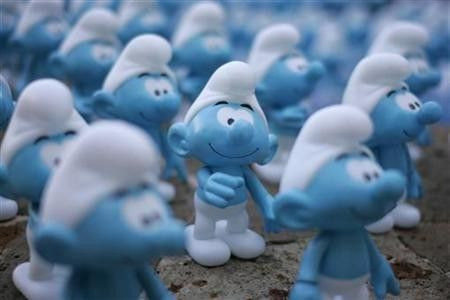How "Smurfs" became a summer box office hit

How could so many people be wrong about Sony's "The Smurfs"?
The retro kids movie emerged this weekend as the surprise box-office hit of the summer after being dismissed by box-office trackers and critics alike.
Coming from nowhere, the film's little blue men overshadowed Steven Spielberg's widely-hyped little green men and took in $36.2 million.
The winning combination came from basic elements that escaped the mainstream water cooler: a clever, targeted marketing campaign, parental nostalgia and a live star-plus-CG character formula that has worked for several other kids movies.
"We were always bullish about this film," studio distribution chief Rory Bruer told TheWrap on Sunday. "Every test screening we had was terrific."
Perhaps it was only those working on the Sony lot who knew what they had -- a clever mix of timeless characters who have already proven irresistible to kids and Neil Patrick Harris to tie it all together.
Parents, it turned out, were looking for a way to entertain their young kids on a weekend when a couple of PG-13 movies also opened. Indeed, about 65 percent of the "Smurfs" audience included parents taking their kids.
Wrap critic Alonso Duralde, who like most of his peers panned the film (it rated a dismal 18 on Rotten Tomatoes), counted Gen Y nostalgia as a factor in the movie's success.
"If you were six in 1982," Duralde noted, "you're 35 now, and you've either got a lingering affection for the Smurfs or you're one of the frazzled parents."
It's not the first time a studio flew under the radar with a kids movie full of cuddly CG characters, with a live-action TV comedy star to tie it all together, only to watch the term "box office shocker!" erupt on Sunday.
In late 2007, Fox dug out of the vault some decades-old singing-chipmunk characters out of the vault, hired Jason Lee (star of NBC's "My Name is Earl" at the time), and spent about $60 million to create the CG/live-action hybrid "Alvin and the Chipmunks." The movie grossed over $360 million for the trouble and was able to spawn a successful franchise.
Earlier this year, Disney took about as much industry ridicule as Sony did for "Smurfs" when it released a CG-based Shakespeare adaptation featuring funny cartoon lawn gnomes.
But "Gnomeo and Juliet," which cost Disney only $36 million to make, grossed almost $190 million worldwide.
Further back, Universal's talking-pig movie "Babe" was the surprise hit of 1995, grossing more than $254 million worldwide.
Indeed, talking cuddly CG characters mixed with live action works consistently -- so long as budgets are kept in line and the execution is good.
At $110 million, the 'Smurfs' production budget was hardly cheap, but still only about half of what the typical CG-3D tentpole runs.
Acquiring the project out of turnaround from Paramount, "Smurfs" was an inhouse collaboration, with Sony divisions including Columbia Pictures and Sony Pictures Animation chipping in on development.
They all went to work on a film that pretty much followed the "Chipmunks" winning formula: live-action Neil Patrick Harris stumbles on adorable characters who are pursued by shrewish evil; young adult character learns to care for others and helps save the oh-so-cute CG sentients from harm in the process.
Sony added enough funny lines to keep the parents engaged -- "Did it ever occur to you that that song is annoying?" Harris asks at one point, when the Smurfs break into their signature "la-la-la."
The marketing was savvy, too. The challenge was to teach kids what a Smurf is, and do it in a cost-efficient way.
Working with NBC Universal -- king of the bargain multi-platform TV buy -- Sony created custom promos, including vignettes, in-show integrations, logo-animations and sneak peeks. One promo showed the Smurfs taking over the NBCUniversal control room.
These promos were presented on a range of platforms including not only NBC, but cable networks Bravo, E!, Oxygen, SyFy, Telemundo, USA and the Weather Channel.
Sony found its audience.
"If you had told me at the beginning of the summer that this would be one of the biggest surprises, I'd have said you were crazy," said a rival-studio distribution executive.
© Copyright Thomson Reuters 2024. All rights reserved.





















